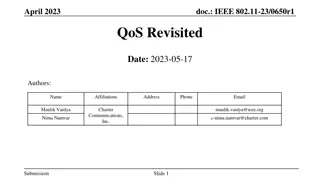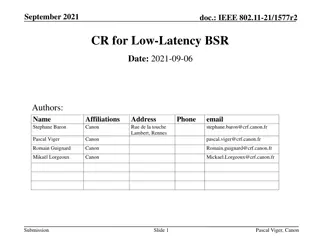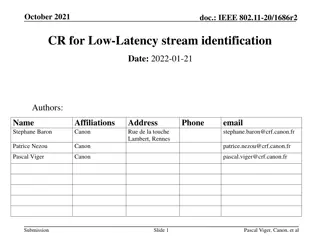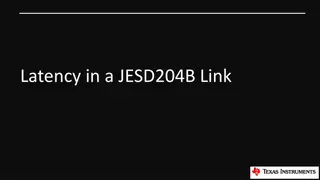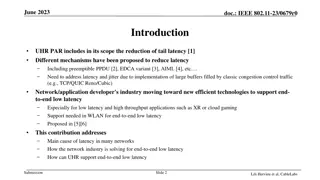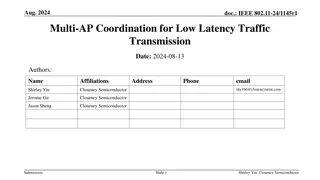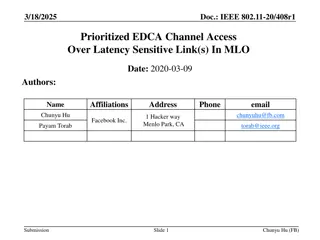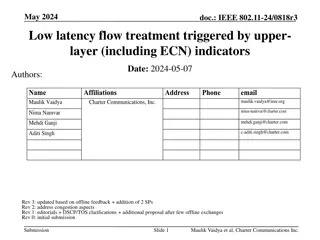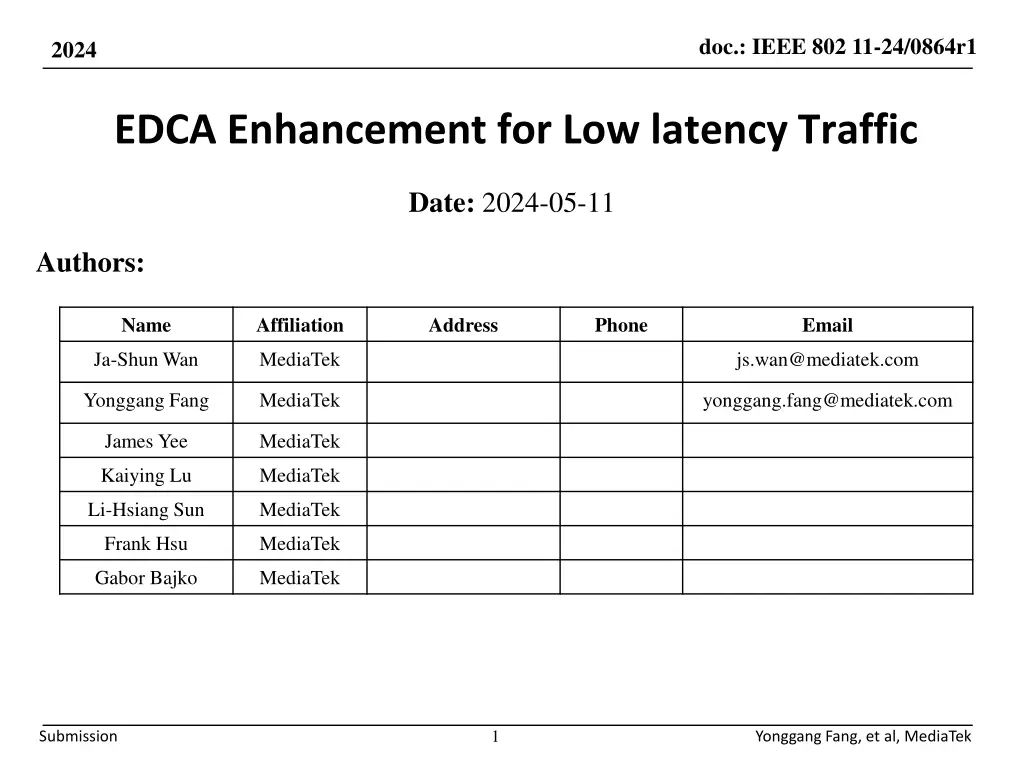
Enhancing IEEE 802.11 EDCA for Low Latency Traffic
"Explore enhancements to the IEEE 802.11 EDCA mechanism for low latency traffic by addressing issues such as collisions and retry failures, proposing solutions like high priority RTS/CTS frame exchange and EIFS protection to improve channel access efficiency and reduce latency issues." (248 characters)
Download Presentation

Please find below an Image/Link to download the presentation.
The content on the website is provided AS IS for your information and personal use only. It may not be sold, licensed, or shared on other websites without obtaining consent from the author. If you encounter any issues during the download, it is possible that the publisher has removed the file from their server.
You are allowed to download the files provided on this website for personal or commercial use, subject to the condition that they are used lawfully. All files are the property of their respective owners.
The content on the website is provided AS IS for your information and personal use only. It may not be sold, licensed, or shared on other websites without obtaining consent from the author.
E N D
Presentation Transcript
doc.: IEEE 802 11-24/0864r1 2024 EDCA Enhancement for Low latency Traffic Date: 2024-05-11 Authors: Name Affiliation Address Phone Email Ja-Shun Wan MediaTek js.wan@mediatek.com Yonggang Fang MediaTek yonggang.fang@mediatek.com James Yee MediaTek Kaiying Lu MediaTek Li-Hsiang Sun MediaTek Frank Hsu MediaTek Gabor Bajko MediaTek 1 Submission Yonggang Fang, et al, MediaTek
doc.: IEEE 802 11-24/0864r1 2024 Introduction This contribution discusses the issues of existing EDCA mechanism and potential methods of reducing channel access collisions for low latency traffic. 2 Submission Yonggang Fang, et al, MediaTek
doc.: IEEE 802 11-24/0864r1 2024 Problem Statement Issues of EDCA for Low latency Traffic (1) Collision could happen when multiple STAs complete backoff at same time and transmit frames together. For example, when the channel is busy, STAs suspend their backoff process till the channel becomes idle and resume at same time. Collision of AC3(AC-VO) data traffic could increase significantly when STAs contend for channel access simultaneously because of small size of CW. RTS/CTS is not mandated for AC3 data transmissions Submission Yonggang Fang, et al, MediaTek 3
doc.: IEEE 802 11-24/0864r1 2024 Problem Statement Issues of EDCA for Low latency Traffic (2) The retry failure: Even EDCA provides retry for failed transmission, but the probability of retry failure is still significant high. For example, AC3: CW = 7 (CWmin=3, CWmax=7) If 3 STAs compete simultaneously, each retry has ~23% chance of collision (1- (7/8)^2). If 8 STAs compete simultaneously, each retry has ~60% chance of collision (1- (7/8)^7). If 16 STAs compete simultaneously, each retry has ~86% chance of collision (1- (7/8)^15). When a collision happen, a STA may still have a chance to miss to transmit a high priority AC data traffic in retries. Submission Yonggang Fang, et al, MediaTek 4
doc.: IEEE 802 11-24/0864r1 2024 Possible Enhancement Proposal (1) Apply (transmit) high priority RTS/CTS frame exchange before transmitting high priority PPDU (e.g., AC3) High Priority RTS: use non-HT format with a fixed TBD data rate Use AIFSN=2, CWmin = 0 and CWmax = 7 for transmitting the RTS. CWmin =0 can make the initial BC=0 so that High Priority AC can always get channel access when competing with other AC. The STAs that sent RTS and collided can perform retry of RTS within EIFS period. If a RTS is received correctly, the responding STA sends a CTS. The RTS transmitter (i.e., TXOP owner) after receiving the CTS response shall suspend the EDCAF for TBD ms; after TBD ms, resets CW=CWmin and BC to a random number within [0, CW]. A backoff suspended requesting STA during the contention resets CW = CWmin and BC to a random number within [0, CW], after receiving a CTS with FCS correctly. Submission Yonggang Fang, et al, MediaTek 5
doc.: IEEE 802 11-24/0864r1 2024 Possible Enhancement Proposal (2) EIFS protection If RTSs from multiple STAs collide, EIFS rules will be automatically applied to protect the transmitting STAs for re-try of RTS A backoff suspended STA will not contend the medium in the EIFS period. An RTS requesting STA but not receiving CTS will increase the CW (limited by CWmax) and then back off again for re-transmitting RTS. o CW = ([CW+1]*2 - 1) or 7 The existing EIFS rules can make collisions converge in subsequent retries. Note: EIFS is mandatory in 802.11 baseline. Submission Yonggang Fang, et al, MediaTek 6
doc.: IEEE 802 11-24/0864r1 2024 Possible Enhancement Benefits Reducing collisions of AC3 low latency data transmissions from multiple STAs. Reducing the number of retries, i.e., the collisions are converged in subsequent retries. Reducing the channel access latency tails of the low latency traffic. Simplifying implementation via reuse existing RTS frame formant with new setting, and no need to define a new frame. Submission Yonggang Fang, et al, MediaTek 7
doc.: IEEE 802 11-24/0864r1 2024 An Example Frame Exchange CW=0 BC=0 CW=1 (retry) BC=0 CW=3 (retry) BC=2 CW=0 (reset) BC=0 STA3 (AC3) RTS RTS RTS CW=0 BC=0 CW=1(retry) BC=0 CW=3 BC=1 STA2 (AC3) PPDU RTS RTS RTS BA CTS EIFS Protection EIFS Protection Remaining BC=3 Remaining BC=3 Remaining BC=3 STA1 Busy Channel Acquisition Time Submission Yonggang Fang, et al, MediaTek 8
doc.: IEEE 802 11-24/0864r1 2024 Convergence Simulation Objective Simulate convergence of RTS collisions during the retries and measure the channel acquisition time Channel Acquisition Time o Starting time: CCA becomes idle o End time: receiving CTS successfully STA3 RTS STA2 RTS RTS PPDU BA CTS PPDU RTS RTS STA1 BA CTS Busy Channel Acquisition Time Channel Acquisition Time Submission Yonggang Fang, et al, MediaTek 9
doc.: IEEE 802 11-24/0864r1 2024 Convergence Simulation 1 Setup 8 STAs with full-buffered AC3 traffic. Perform EDCA for UL transmission Enhanced EDCA for AC3 traffic AIFSN = 2 Initial CW = CWmin (0) Backoff Counter: random [0, CW] Retry (A) CW=(CW+1)*2-1 (B) CW=7 Reference EDCA for AC3 traffic Follow 802.11 default setting STA00 STA01 AP0 STA07 Submission Yonggang Fang, et al, MediaTek 10
doc.: IEEE 802 11-24/0864r1 2024 Convergence Simulation 1 Result Channel Acquisition Time (CDF) The proposed method can make collision convergence better than the reference EDCA for AC3 traffic The proposed method with CW=7 for retry has better performance of the convergence tail When multiple STAs perform backoff with CWmin=0 simultaneously, RTSs collide at beginning, but converge quickly after 200us. channel acquisition time (ms) Submission Yonggang Fang, et al, MediaTek 11
doc.: IEEE 802 11-24/0864r1 2024 Convergence Simulation 2 Setup 16 STAs with full-buffered AC3 traffic. Perform EDCA for UL transmission Enhanced EDCA for AC3 traffic AIFSN = 2 Initial CW = CWmin (0) Backoff Counter: random [0, CW] Retry (A) CW=(CW+1)*2-1 (B) CW=7 Reference EDCA for AC3 traffic Follow 802.11 default setting STA00 STA01 AP0 STA15 Submission Yonggang Fang, et al, MediaTek 12
doc.: IEEE 802 11-24/0864r1 2024 Convergence Simulation 2 Result Channel Acquisition Time (CDF) The proposed method can make collision convergence better than the reference EDCA for AC3 traffic When multiple STAs perform backoff with CWmin=0 simultaneously, RTSs collide at beginning, but converge quickly after 200us. channel acquisition time (ms) Submission Yonggang Fang, et al, MediaTek 13
doc.: IEEE 802 11-24/0864r1 2024 E2E Delay Simulation Objective Simulate the E2E delay for low latency traffic transmission o Starting time: receiving the packet from the upper layer o End time: delivering the received packet to the upper layer o AC1 TXOP: 5.484ms Delivering time to upper layer Receiving time from upper layer Data STA2 PPDU RTS RTS BA CTS Busy STA1 E2E Delay for AC3 traffic Submission Yonggang Fang, et al, MediaTek 14
doc.: IEEE 802 11-24/0864r1 2024 E2E Delay Simulation 1 Setup 1 STA has AC3 traffic (1pkt/10ms) to AP 7 STAs transmit full-buffered AC1 traffic to AP Simulate EDCA for UL transmission Enhanced EDCA for AC3 traffic AIFSN = 2 Initial CW = CWmin(0) Backoff Counter: random [0, CW] Retry CW = 7 Reference EDCA for AC1 and AC3 traffic Follow 802.11 default setting STA00 STA01 AP0 STA07 Simulation Setup Topology Submission Yonggang Fang, et al, MediaTek 15
doc.: IEEE 802 11-24/0864r1 2024 E2E Delay Simulation 1 Result E2E application packet delay time (ms) for AC3 traffic The simulation result shows RTS/CTS with (CWmin=0, CWmax=7) for retries has better performance of the latency tail. The E2E traffic delay of using Enhanced EDCA worse than legacy AC3 traffic is caused by RTS/CTS before data transmission. The E2E traffic delay is related to the receiving time of the low latency traffic from the upper layer during the channel busy period (TXOP) occupied by AC1 traffic. The closer of the receiving time approaching to the end of TXOP, the less E2E delay the low latency traffic has. The worst E2E delay is roughly equal to the time of TXOP occupied by AC1 traffic. Submission Yonggang Fang, et al, MediaTek 16
doc.: IEEE 802 11-24/0864r1 2024 E2E Delay Simulation 2 Setup 1 STA has AC3 traffic (1pkt/10ms) to AP 15 STAs transmit full-buffered AC1 traffic to AP Simulate EDCA for UL transmission Enhanced EDCA for AC3 traffic AIFSN = 2 Initial CW = CWmin(0) Backoff Counter: random [0, CW] Retry CW = 7 Reference EDCA for AC1 and AC3 traffic Follow 802.11 default setting STA00 STA01 AP0 STA15 Simulation Setup Topology Submission Yonggang Fang, et al, MediaTek 17
doc.: IEEE 802 11-24/0864r1 2024 E2E Delay Simulation 2 Result E2E application packet delay time (ms) for AC3 traffic Submission Yonggang Fang, et al, MediaTek 18
doc.: IEEE 802 11-24/0864r1 2024 E2E Delay Simulation 3 Setup 8 STA has AC3 traffic (1pkt/10ms) to AP 8 STAs transmit full-buffered AC1 traffic to AP Simulate EDCA for UL transmission Enhanced EDCA for AC3 traffic AIFSN = 2 Initial CW = CWmin(0) Backoff Counter: random [0, CW] Retry CW = 7 Reference EDCA for AC1 and AC3 traffic Follow 802.11 default setting STA00 STA01 AP0 STA15 Simulation Setup Topology Submission Yonggang Fang, et al, MediaTek 19
doc.: IEEE 802 11-24/0864r1 2024 E2E Delay Simulation 3 Result E2E application packet delay time (ms) for AC3 traffic With the proposed method Without the proposed method Submission Yonggang Fang, et al, MediaTek 20
doc.: IEEE 802 11-24/0864r1 2024 Summary This contribution discusses the collision and retry issue of existing EDCA mechanism proposes a potential enhancement: reduce collisions of AC3 low latency data transmissions from multiple STAs. reduce the number of retries, i.e., the collisions are converged in subsequent retries. reduce the channel access latency tails of the low latency traffic. Submission Yonggang Fang, et al, MediaTek 21

